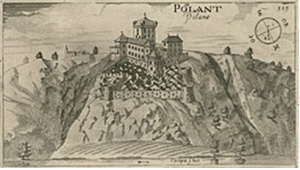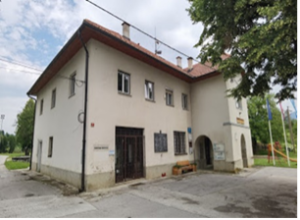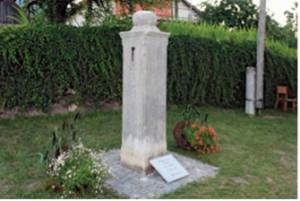Nekoč pomemben grad, ki ga danes ni več
Grad Poljane je nekoč stal na robu naselja Predgrad v Poljanski dolini ob Kolpi. Danes je težje opaziti ruševine gradu, vendar se jih še zmeraj nekaj nahaja pod pomolom cerkve sv. Sebastjana v Predgradu. Viri navajajo, da je bil zgrajen okoli ali po letu 1250, točnega leta izgradnje ne poznamo. Sodi v zgodnjo gotiko, za katero so značilni zašiljen lok, rebrast obok in zunanji oporni loki, prav tako je to arhitektura številnih gradov, palač, mestnih hiš, cehovskih dvoran in univerz.
Grad spada v arhitekturo, kar pomeni, da je bil izoblikovan oz. zgrajen s pomočjo kamna, lesa in vezalne mesi, da so to lažje oblikovali, so si pomagali s klesanjem in oblikovanjem. Z grajenjem gradov so pokazali, da ima umetnost lahko tudi funkcionalno vlogo zlasti v času turških vpadov.

Slika 1: Grad Poljane v Valvasorjevi topografiji leta 1679 (Vir: https://sl.wikipedia.org/wiki/Grad_Poljane#/media/Slika:Valvasor_-_Grad_Poljane.jpg)
Čeprav se Grad Poljane prvič omenja v listinah leta 1325 kot »castrum Poelan«, so ga najverjetneje dali pozidati oglejski patriarhi po letu 1250. Grad je sestavljalo grajsko jedro (stolp, palacij, stolpasta stavba). Sodil je tudi med bergfride, saj je imel visok stolp, ki je bil značilen za gradove srednjega veka v državah pod nemško nadoblastjo. Kapela se je nahajala severno nad gradom, vendar ne na istem mestu, kjer stoji sedanja cerkev. Po hrbtu ozkega grebena je bila razpotegnjena ozka skupina poslopij in drugih gradenj. Imel je tudi tri dvižne mostove, čez prvi jarek je vodil prvi dvižni most, drugi je ležal v zahodnem priključku spodnjega jarka, tretji dvižni most pa je neposredno vodil v samostojni glavni stolp. Največji obseg je imel v času turških vpadovv 2. polovici 15. stoletja, saj mu je bil prizidan tabor s 40 hišami.
Turki so grad porušili med 1460 in 1530, ampak je bil nato obnovljen. Njegovi lastniki so se v naslednjih letih menjali, dokler ga leta 1641 niso kupili Turjaški. 16. oktobra 1809 ga je dal požgati francoski general Souchy, ker so se upirali davkom. Iz ruševin gradu so nato Turjaški sezidali graščino Poljane.

Slika 2: Poljanska graščina (Vir: https://gradovislovenije.si/project/poljane-pollant/)
V okolici graščine se je nahajal manjši park in manjša stanovanjska ter gospodarska poslopja. Ponovno so jo požgali partizani v noči z 19. na 20. maj 1943. Graščina Poljane je bila po vojni zopet obnovljena in danes je v njej Krajevni urad Predgrad, sedež Krajevne skupnosti Poljanska dolina, zdravstvena postaja in večnamenska dvorana. Pred stavbo si danes lahko ogledamo 2 metra visok sramotilni steber, imenovan pranger, ki je nekoč stal v okolici gradu.

Slika 3: Sramotilni steber »pranger« (Vir: https://life-kocevsko.eu/sramotilni-steber-pranger/)
Umetnina me je zelo pritegnila s svojo zgodovino, za katero sploh nisem vedel, čeprav sem bil že velikokrat v graščini, ki jo je nasledila. Moram priznati, da je imela velik pomen za tisti čas, še posebej v času turških vpadov, ko je ljudem predstavljala varnost in udobje. Seveda bi jo bilo lažje opisovati, če bi se nahajala tam še danes, tako pa sem si jo lahko le nekako predstavljal po virih, ki sem jih preučil in po Valvasorjevi upodobitvi. Zgodovinski dogodki niso bili najbolj naklonjenim umetninam, zato je bila večkrat porušena ali poškodovana. Za prebivalce Poljanske doline, je bila zelo pomembna, saj so jo velikokrat obnovili in menim, da so z gradnjo nove graščine na območju porušenega gradu hoteli, saj delno ohraniti svojo dediščino.
Jože Kralj, 3. b (šol. l. 2021/2022)
VIRI IN LITERATURA:
- Grad Poljane. Društvo Gradovi Slovenije. Dostopno 2. 12. 2021 na spletni strani društva: https://gradovislovenije.si/project/grad-poljane-
- Grad Poljane. Kočevsko. Dostopno 9. 12. 2021 na spletni strani Wikipedije: https://www.kocevsko.com/sl/poi/grad-poljane/
- Grad Poljane. Wikipedija. Dostopno 9. 12. 2021 na spletni strani Wikipedije: https://sl.wikipedia.org/wiki/Grad_Poljane
- Gotska arhitektura. Wikipedija. Dostopno 9. 12. 2021 na spletni strani: https://sl.wikipedia.org/wiki/Gotska_arhitektura
- Wikipedija. Dostopno 9. 12. 2021 na spletni strani: https://sl.wikipedia.org/wiki/Bergfrid
- MAKAROVIČ, M. (2007). Predgrad in Predgrajci. Grad Poljane. Kočevje. Pokrajinski muzej Kočevje. Str. 20-23.
THE POLJANE CASTLE IN THE POLJANE VALLEY BY THE KOLPA RIVER
Once an important castle, that is now gone
The Poljane Castle once stood on the edge of the settlement Predgrad in the Poljane Valley by the Kolpa River. Today it is harder to see the ruins of the castle, but there are still some under the supporting pier of the church of St. Sebastian in Predgrad. According to the sources it was built around or after 1250, but the exact year of construction is unknown. It belongs to the Early Gothic period, characterised by pointed arches, ribbed vaults and external buttresses, and it is also the architecture of many castles, palaces, town halls, guild halls and universities.
The castle belongs to architecture, which means that it was shaped or built using stone, wood and binding mixture. In order to make the design proces easier, they used carving and moulding techniques. By building castles, they showed that art could also play a practical role, especially during the Turkish invasions.
Although the Poljane Castle is first mentioned in documents in 1325 as “castrum Poelan”, it was probably built by the Patriarchs of Aquileia after 1250. The castle consisted of a castle core (tower, palace, turreted building).It can also be classified as a “bergfrid”, as it had a tall tower, which was typical of medieval castles in German-ruled countries. The chapel was located north above the castle, but not at the site of the present-day church.A narrow group of buildings and other structures stretched along the narrow ridge. It also had three drawbridges. The first drawbridge spanned the first trench, the second one was located in the western function of the lower trench, and the third drawbridge led directly to the independent main tower. It was at its largest during the Turkish invasions in the second half of the 15th century, when a camp with 40 houses was added.
The castle was destroyed by the Turks between 1460 and 1530, but was later rebuilt. Its owners changed over the years until it was bought by the Auerspergs in 1641. On 16 October 1809, the French general Souchy burnt the castle down, because people resisted paying taxes. The Aurspergs then built the Poljane Manor from the ruins of the castle.
A small park and small residential buildings and outbuildings surrounded the manor. It was again burnt down by the partisans in the night of 19 to 20 May 1943. After the war, The Poljane Manor was rebuilt again. Today the building hosts the Predgrad Local Office, the Poljanska dolina Local Community Headquarters, a health station and a multi-purpose hall. In front of the building, we can now see a 2 meter tall pillar of shame, called »pranger«, which once stood in the castle’s vicinity.
I was attracted to the artwork because of its history, which I didn’t know, although I had visited the manor that replaced the castle many times. I must admit that it was important in that time, especially during the Turkish invasions, when it offered security and comfort to the people. Of course, it would be easier to describe it, if it still existed today, but I could only imagine it based on the sources I have studied and Valvasor’s depiction. Historical events have not been kind to the artwork, which is why it was demolished or damaged several times. For the inhabitants of the Poljane Valley, it was very important, as they rebuilt it many times and I believe that by building a new manor on the site of the ruined castle, they wanted to preserve a part of their heritage.
Jože Kralj, 3. b (šol. l. 2021/2022)
Sources and Literature:
- Grad Poljane. Društvo Gradovi Slovenije. Cited: 2 December 2021: Available at: https://gradovislovenije.si/project/grad-poljane-
- Grad Poljane. Kočevsko. Cited: 9 December 2021. Available at:
- https://www.kocevsko.com/sl/poi/grad-poljane/
- Grad Poljane. Wikipedija. Cited 9 December 2021. Available at: https://sl.wikipedia.org/wiki/Grad_Poljane
- Gotska arhitektura. Wikipedija. Cited 9 December 2021. Available at: https://sl.wikipedia.org/wiki/Gotska_arhitektura
- Wikipedija. Cited: 9 December 2021. Available at: https://sl.wikipedia.org/wiki/Bergfrid
- MAKAROVIČ, M. (2007). Predgrad in Predgrajci. Grad Poljane. Kočevje. Pokrajinski muzej Kočevje. Page 20-23.